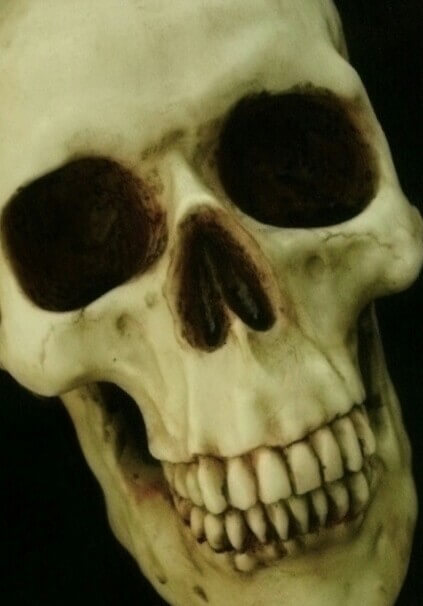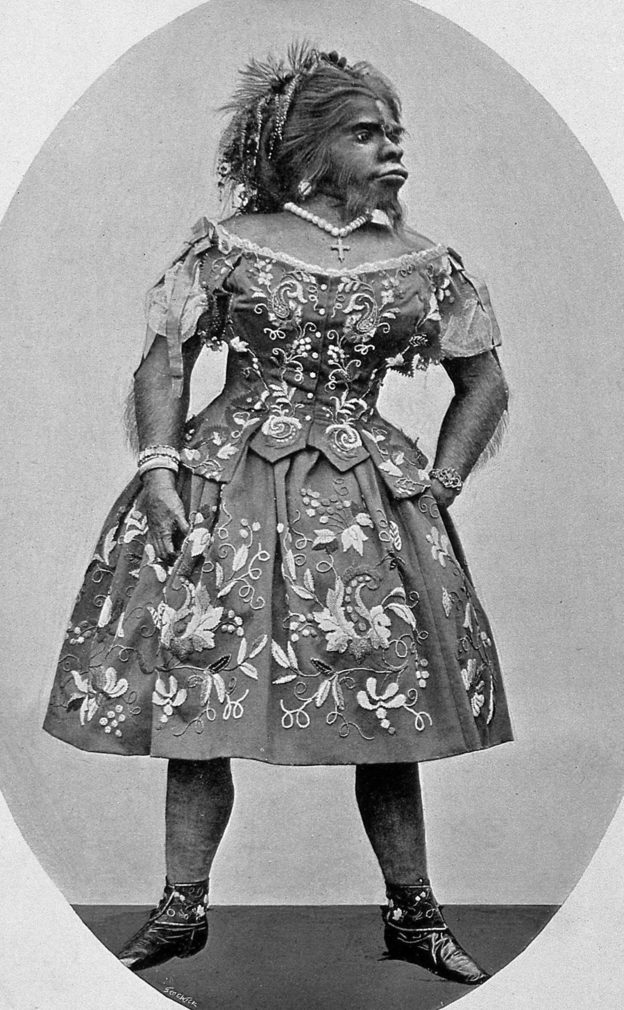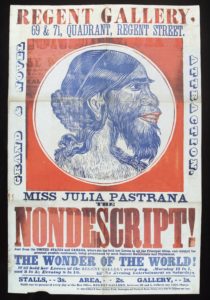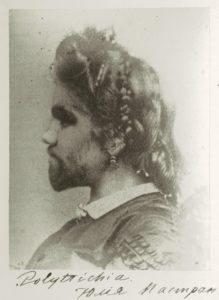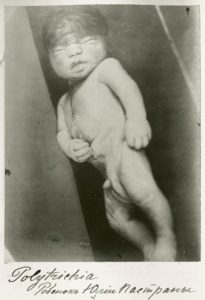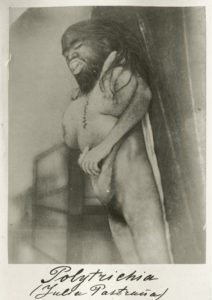While records related to the birth of Julia Pastrana are somewhat blurred, it is likely that she was born on the Sierra Madre’s Western slopes of Mexico. It is believed that she was born in the year 1834 (died: March 25, 1860). At that time, her physical characteristics of thick lips, wide ears and excessive hair growth caused great confusion: Some individuals theorized that she was the offspring of a human and an ape, a bear or a baboon, which led to her nicknames, ‘The Bear Woman,’ ‘The Baboon Lady’ and ‘The Ape Woman.’
Author Jan Bondeson Recounts Pastrana’s Early Life
In Jan Bondeson’s book, “A Cabinet of Medical Curiosities,”, he writes that, the exaggerated accounts in the exhibition pamphlets state that in the year 1830, an Indian woman (Espinosa) became separated from her tribe: Her tribe believed that she had drown. However, 6 years later several cowboys found her in one of the caves. Espinosa told the cowboys that a party of hostile Indians had captured her and then imprisoned her within the cave. Although the cowboys looked for others, no human beings were found nearby. Espinosa had a small girl with her, she stated the little girl was not actually her daughter; even so, Espinosa decided to care for her and love her. The child was christened Julia Pastrana. Several years later, when Julia’s ‘mother’ passed away, she was sent to an orphanage in a nearby city. Julia was described as an intelligent, sweet and excessively hairy girl. Due to her unique physical characteristics, Julia quickly became somewhat of a local celebrity.
Julia Pastrana – The Servant Girl
When the state of Sinaloa’s governor heard of Julia’s unusual physical characteristics and sweet disposition, the governor decided to adopt her. Julia became the live-in maid and a form of amusement for the governor. Unfortunately, she was not treated kindly: Therefore, once she turned 20 years old, Julia decided to return to her tribe.
Her Journey as an Entertainer Begins
As Julia headed back to the mountains, she met an American man by the name of M. Rates. He convinced Julia to become an entertainer and to tour with him. In December of 1854, Julia made her debut at the Gothic Hall in New York City. While wearing a red dress and dancing the Highland Fling, Julia sang Spanish folk tunes. Her career as an entertainer was off to a great start as huge crowds flocked to see her. Needless to say, it was not necessarily her singing and dancing that attracted these large audiences, most likely, it was her unique, animal-like physical characteristics. At this time, Julia was billed the “Bear Woman from the Wilds of Mexico!”
Happily, Ever, After
While visiting New York, Pastrana met and then married impresario Theodore Lent. Lent became her manager. Although historians believe that Pastrana was truly in love with Lent, the New York Times reports that Lent only married her as a means to control her wages. Lent exploited his wife through traveling exhibitions in the United States, Canada and all over Europe.
Physicians from the 1800’s Chime-In on Pastrana’s Heritage
Initially, as Lent toured with his wife, he referred to her as ‘The Bear Woman.’ However, during a private viewing, physician Alexander B. Mottson, who is the son of the well-known New York surgeon Valentine Mott, declared that Julia was a hybrid: Half-human and half-orangutan. Mott was not alone in his beliefs as many other physicians agreed with his declaration. This belief may be what led to her other stage names, ‘The Baboon Lady’ and ‘The Ape Woman.’ At this time, orangutans were considered wild and primitive; Hence, this declaration of Julia’s heritage may have exacerbated the fear that some individuals experienced upon seeing Julia.
Edgar Allen Poe Lends Credence to the Belief that Orangutans Are Wild, Primitive and Dangerously Sexual
Edgar Allen Poe’s story The Murders in the Rue involves a rampaging orangutan who uses a straight razor to slit the throats of beautiful women. In addition, two hundred years before Poe’s 1841 story, a Dutch physician by the name of Jacob Bontius documented that orangutans were “born for the lust of Indian women who mix with apes and monkeys with detestable sensuality.”
Pastrana and Lent’s Baby Boy is Born in Moscow
Pastrana became pregnant in 1859. Upon his birth, it was evident that their son had inherited hypertrichosis. As Julia held their son, she looked to Theo for comfort, instead of comforting her Theo calls her the ‘bear woman’ and then states ‘here is her bear cub!’ She wanted Theo to reach down and touch their son or her hand; however, instead Theo jerked his head away and started to bark and laugh. Sadly, their son passed away in Julia’s arms just 35 hours after his birth. Pastrana died five days later due to complications related to her son’s birth: She was only 26 years old.
Theodore Lent Lacks Boundaries
Even after her death, Lent continued to display his wife’s body: Furthermore, he put the corpse of their newborn son on display for all to see. He accomplished this task by having the two of them embalmed, stuffed and mounted.
Lent’s Second Marriage
Eventually, Lent did marry again: This time he married a bearded woman. He propped the bodies of Julia and their son up against the glass to display them at the same time he displayed his bearded wife. He billed this ‘new’ wife as Pastrana’s sister (Zenora Pastrana).
What Happened to Theodore Lent?
At some point, Lent ended up in a mental institution. Even after being admitted to the mental institution, the bodies of Pastrana and their son continued being featured in exhibitions. Lent remained institutionalized until his death in 1884.
Pastrana’s Remains Stolen from a Warehouse in Norway
In 1976, Julia and her son were stored in a warehouse: Thieves broke into the warehouse and took both of their bodies. When the police located their remains in a trash bin; Julia’s arm was dismembered and her son’s body was unsalvageable.
Julia Pastrana’s Remains Are Returned to Mexico for Burial
Even after more than 150 years, Julia’s remains had yet to be buried. In 1996, Julia’s remains were taken to the Institute of Forensic Medicine at the University of Oslo in Normandy. Her remains were placed in a storage room. Upon learning the whereabouts of Julia’s body, New-York based visual artist Laura Anderson Barbata campaigned for 10 years demanding that Julia’s body be returned to Mexico for a proper burial. Barbata’s campaign was successful and Julia’s body was returned to Mexico.
On Feb. 12, 2013, following a Roman Catholic mass, Pastrana’s coffin was taken to Sinaloa de Leyva’s cemetery to be laid to rest: All the while, a band played traditional music. Despite the fact that no one knew Julia Pastrana personally, hundreds of people attended her funeral.
The True Cause of Pastrana’s Physical Characteristics
If Julia had been born in modern times, we could have diagnosed her and put to rest all of the myths related to her heritage. The reality is that Julia suffered from two rare genetic disorders that caused her to have a thick-set jaw (gingival hyperplasia) and excessive hair growth (hypertrichosis). This excessive hair growth has led to the condition being referred to as the ‘werewolf syndrome.’ Unfortunately, there is no cure for congenital hypertrichosis. Furthermore, an affected female’s baby has a 50 percent chance of being born with the condition.
Julia Pastrana: Much More Than Meets the Eye
Information related to Pastrana’s life can be found in 19th century history books. According to this documentation, she adored singing, music and dancing. She also enjoyed learning about different languages. In addition, Pastrana generously gave to local charities.
Final Thoughts…
While we all have insecurities about the way we look, Julia Pastrana can be a beacon for those of us who look in the mirror and do not like what we see. Despite being billed ‘The World’s Ugliest Woman,’ Julia stepped out on stage and displayed her unique physical characteristics as she entertained her audiences with song. It has been said that she sang beautifully as her voice resembled the sound of a bell. There is no doubt in my mind that as she performed her heart of gold shone through.
Unfortunately, Julia and her son, were taken advantage of by the man who was supposed to protect them. He took advantage of her in life, and in death. As far as happy endings go, at least his final days were spent in a mental institution (which is right where he belonged!). RIP Julia and baby Pastrana.
Sources:
⦁ http://www.isciencetimes.com/articles/4523/20130213/ape-woman-buried-150-years-julia-mexicos.htm
⦁ https://www.theguardian.com/world/2013/feb/13/mexican-ape-woman-buried
⦁ http://pictorial.jezebel.com/the-life-and-death-of-julia-pastrana-bearded-woman-on-1695330616
⦁ http://www.isciencetimes.com/articles/4523/20130213/ape-woman-buried-150-years-julia-mexicos.htm
Interesting reads:
⦁ http://www.juked.com/2015/10/kat-solomon-julia-pastrana.asp
⦁ http://ireport.cnn.com/docs/DOC-762567
⦁ http://www.lauraandersonbarbata.com/work/mx-lab/julia-pastrana/3.php
